Updated: February 13th, 2023
This article contains affiliate links. Read the full disclosure here.
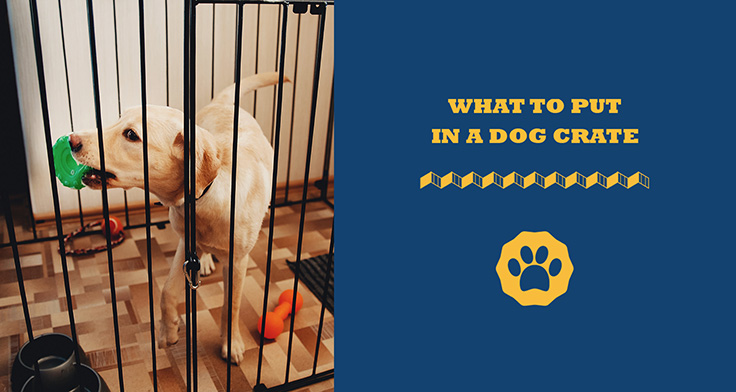
In our series of articles dedicated to crate training, we have already talked about the benefits of crate training, when you should use it, when you shouldn’t crate your dog, and how to choose the right crate. Today, we turn our attention to the important questions of what to put in a dog crate, what not to put in a dog crate, and where exactly to put their crate.
To get the full benefits of crate training, it needs to be done right. This means establishing the crate as a safe place that is the domain of the dog, kind of like a child’s bedroom. It should be a positive, warm, and happy place for your dog, and certainly, it should never feel like a prison.
The key to achieving this is making sure the crate is effectively located in the home, somewhere that lets your dog still feel like part of the family and not as if they are being punished. Similarly, it should contain things that make the space feel cozy and like home.
An Overview Of The Top Dog Crate Accessories
We highly recommend looking at the comparison table we have below where we highlight the features of each product.
| IMAGE | PRODUCT | ||
|---|---|---|---|
|
Best portable sleeping spot for any crate
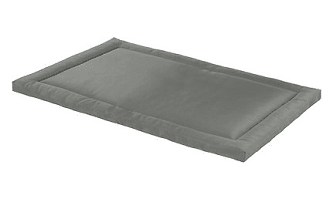 |
Best portable sleeping spot for any crate
|
|
CHECK PRICE → |
|
Best Dog Crate Toys
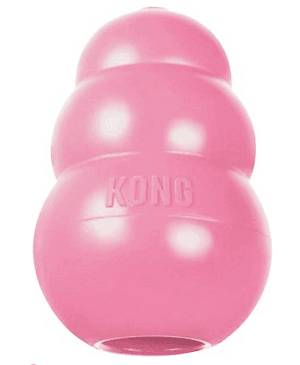 |
Best Dog Crate Toys
|
|
CHECK PRICE → |
|
Best Dog Crate Chew Toys
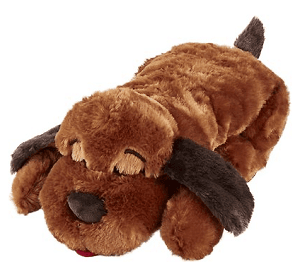 |
Best Dog Crate Chew Toys
|
|
CHECK PRICE → |
|
Best Crate Bedding for Adult Dog
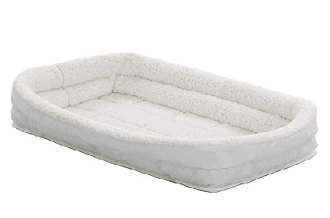 |
Best Crate Bedding for Adult Dog
|
|
CHECK PRICE → |
|
BEST LICKABLE DOG WATER BOTTLE
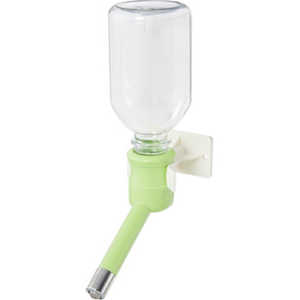 |
BEST LICKABLE DOG WATER BOTTLE
|
|
CHECK PRICE → |
|
BEST CRATE COVER
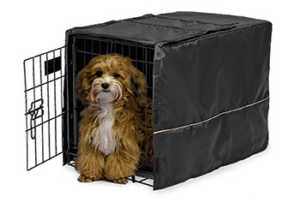 |
BEST CRATE COVER
|
|
CHECK PRICE → |
|
BEST CRATE MOUNTED WATER BOWL
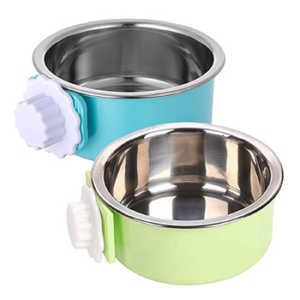 |
BEST CRATE MOUNTED WATER BOWL
|
|
CHECK PRICE → |
|
BEST CHEW-PROOF DOG BED 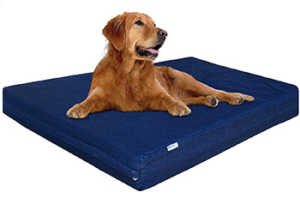 |
BEST CHEW-PROOF DOG BED |
|
CHECK PRICE → |
What To Put In A Dog Crate & Why
The ideal dog crate should be a warm and welcoming place of comfort and security where your dog likes to spend carefree time enjoying a good relaxing chew session or resting and indulging in some sleep.
Being a small, enclosed space automatically gives them a secure den-like feeling, but without a few accessories, a crate is hardly a comfortable and enticing place. So, to make it more comforting, you should add a few things to make it nice for your dog or puppy.
The things you could put in a crate include bedding, toys, and sources of food and water. But it’s important to keep in mind not everything is suitable for a crate, and some things can even be dangerous.
Dog Crate Bedding
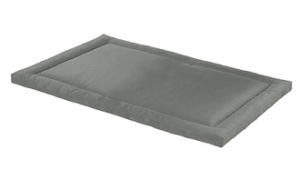
Helix Durable Dog Bed & Crate Mat
It’s a nice idea to put bedding in the crate with your dog to make it a bit more comfortable. They would much rather snuggle up against a soft blanket than the cold steel of the crate.
However, you do need to be careful while choosing suitable bedding. Puppies are notorious for chewing on everything, as are some breeds of older dogs like golden retrievers. As a result, blankets and bath towels can quickly be destroyed. Not only is this a waste of money and a mess, but the smaller pieces can become a serious choking hazard.
For similar reasons, for some dogs, ‘plush’ or ‘soft-stuffed’ dog beds aren’t suitable, either.
You know your dog and whether they are a chewer, so it is up to you to decide what is going to work.
If you do need chew-proof bedding, we recommend the Helix Durable Dog Bed & Crate Mat, used by countless vets and kennels worldwide.
This mat is soft and comfortable while being extremely strong and durable. It’s still not totally destruction-proof, but it’s far tougher than almost any other alternative.
It’s also non-allergenic, warm and insulating, and permeable, meaning moisture gets drawn away while air can flow through, making the mat ideal for puppies or elderly dogs that may have an ‘accident’ in the crate.
My recommendation is to start by using the Helix Crate Mat and then, when your puppy proves they can be trusted not to chew, you can change to any bedding of your choosing.
If your dog has already learned the art of not chewing up their bed, then you have many more options.
Try to go for a nice, thick, extremely comfortable stuffed bed with raised edges they can really snuggle into and against—because your dog deserves the best in comfort, don’t they?
One of the best options is the MidWest Quiet Time Deluxe Double Bolster Pet Bed. Comfort aside, it has a double bolster that unrolls to create a bumper around the crate’s perimeter. Elastic straps on its bottom will also help you secure it to your crate.
Dog Crate Toys
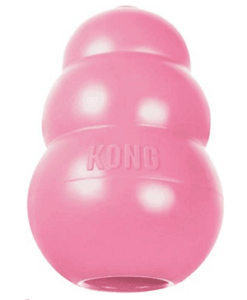
There are so many dog toys available that it’s hard to decide what’s good or not, and certainly not all toys are suitable.
Remember that when they are in the crate, your dog is probably going to be unsupervised, whether that’s because you aren’t at home or because you are asleep.
This means they should only have access to toys that are safe to use while unsupervised. This also means no toys with small bits they can break off and swallow and no toys with pieces they can get caught up in and become trapped and distressed.
This largely limits you to durable chew toys your pup isn’t going to be able to break. And the keyword is ‘durable.’
KONG toys are ideal and are somewhat the globally agreed-upon standard. They are extremely durable and can even be stuffed with tasty food and frozen treats, so a puppy can work at getting the treats out over time to keep them entertained.
There are many benefits associated with leaving such toys in a crate:
- It gives them something to do! ‘Occupational chewing’ keeps them relaxed and happy, chewing being a favorite pastime for most dogs!
- It gives them an alternative to chewing their bedding.
- It leads to a puppy forming a habit of chewing on the correct things—their toys—which means less chance of them chewing on your possessions when alone outside of the crate.
- Knowing they get to relax with their toys increases their enjoyment of the crate and helps them look forward to spending time there.
Just one more thing to keep in mind is to make sure the toys you supply are a suitable size for the mouth of your dog.
Click here for our review of the best toys suitable for puppies.
But Can You Leave Soft Toys In The Crate?
Whether or not your dog can have soft toys in their crate with them depends very much on your dog and whether they can be trusted with these types of toys.
That said, for a new puppy and their first few nights home, a Calmeroos Puppy is often a very good idea.
A Calmeroos Puppy is a soft toy that somewhat emulates being curled up with littermates they’ve just recently left behind.
You can insert a heat pack into the toy to provide warmth, and there’s a ‘real-feel,’ battery-driven heartbeat. These unique features help your puppy feel as though they’re curled up in another dog’s company.
If you can combine this with a piece of cloth from the litter’s box at the breeder’s, to provide a familiar scent, the combination can do wonders for preventing crying at night due to loneliness and separation from your puppy’s mother and littermates.
You do have to keep an eye on your puppy, though, because this is a toy that’s easily chewed and destroyed by determined chewers, so your puppy may swallow pieces. If they do become a destructive chewer, you shouldn’t leave this toy in the crate with them any longer—only the durable chew toys.
Until your puppy is three months old or so, the soft toy will be fine—they will hardly be strong enough to destroy it—but after this period, I recommend not leaving any toys in the crate with them at all. It’s always better to be safe than sorry.
Food And Water
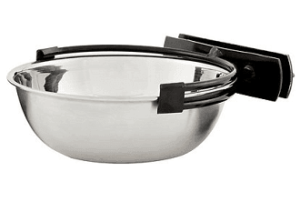
MidWest Stainless Steel Snap’y Fit Dog Kennel Bowl
While you should never leave your dog alone for long periods of time without access to water, as a general rule, you should not be leaving food and water in their crate.
Most puppies have to wee very shortly after taking a drink, so if you leave water in the crate with them, there’s a high chance they will end up soiling their crate.
This goes against all good house training advice, as once they start peeing in the crate, they will start seeing the crate as a place where it is OK to go potty.
However, if you’re going to leave them crated for two or more hours, especially if it’s a warm day, then you are going to have to leave them some water. We recommend a sturdy, crate-mounted water bowl – the type that clamps to the crate so it cannot be spilled.
However, if you’re going to be gone for a while, the best solution would be to have someone come in and let them out for a short period before crating them again. That’s because if you leave your dog crated for many hours, they can easily become depressed, sad, and anxious. While your dog is out of the crate, the person can give them water and/or food and also allow them to relieve themselves in case they are pressed.
But what if your dog has a condition that calls for constant access to water? Diabetes and urinary tract complications are notorious for causing this. But rather than use a crate-mounted water bowl, I would advise you go for a lickable dog water bottle.
The great thing about this particular type of water bottle is it will not wet her bed, spill water in the crate, or create a mess. A perfect example is the Choco Nose No-Drip Dog Water Bottle. Beyond being drip-resistant, it’s chew-proof and easy to attach and detach from your pup’s crate. Just remember to help your dog learn how to lick water from it.
Again, don’t leave food in your pup’s crate in a way that gives them free access to food whenever they want it.
Puppies and dogs should have definite, consistent feeding times rather than being left to graze. Eating throughout the day can play havoc with their bathroom schedule and seriously undermine their house training. Click here to learn how much to feed a Golden Retriever puppy.
Ideally, dogs should have regular meal times, which will help you maintain regular potty times, too.
Although you shouldn’t leave food in the crate, you can feed your dog their main meal inside the crate. This can help promote the idea that the crate is a source of only good things.
Chew toys with treats inside should be OK, as your puppy hopefully isn’t getting enough calories at once to trigger their need for the bathroom. But do remember to subtract their treat calories from the overall number of calories you feed them each day.
What About A Pee Mat?
You might be tempted to leave something like a pee mat in your puppy’s crate as well, in case they do have an accident overnight. But again, this is not advised.
This is because pee mats are designed to tell your dog that this is the right place to do their business, and this is the last thing you want them thinking about in their crate.
If they are a little accident-prone and you don’t want to be cleaning pee out of your carpet, put a protective layer such as cardboard or a plastic sheet under the crate, preferably where your dog can’t see it–and invest in a good pet urine stain remover.
Should You Cover Your Dog’s Crate?
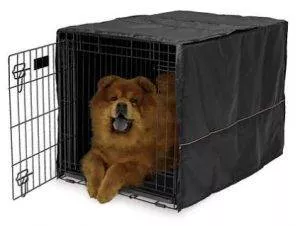
Whether your dog likes its crate covered or not comes down to personal preference, so you will need to experiment.
Most dogs prefer their crate covered because it offers a nice, cozy, enclosed, and secure feeling. Being covered also helps them take their mind off everything on the outside of their crate, so they feel much more relaxed.
However, some dogs do like the ability to look around and see what’s happening in their environment, and they will therefore prefer their crate not to be covered.
To see what your dog prefers, try it out, always leaving one side of your dog’s crate uncovered. Leave it partially covered for a little while, even if they don’t like it at first, as they might just be adjusting. However, if at any point they look like they are in real distress, then remove the covering immediately.
I recommend buying an actual crate cover rather than going DIY with towels and blankets. This is because your puppy can pull these soft coverings into the crate with them, leaving a lot of destruction in their wake. But again, this is a judgment call based on whether your dog is the type that is likely to do this.
Meanwhile, when you go shopping for crate covers, look out for the MidWest Dog Crate Cover. Thousands of pet owners continue to buy it not just because it fits most crates but also due to its durability, ease of use, and multiple flaps.
Where Should You Put Your Dog’s Crate During The Day?
You should put your dog’s crate in the busiest room of your home where everybody spends their time and hangs out, whether that be a living room, dining room, or the kitchen.
Keep in mind that dogs are highly social, and they want and need to feel they’re a part of your family and everything going on, to be happy and fulfilled.
By having their crate out of the way, in a room away from the family, they will feel isolated and excluded. They will feel like they’ve been abandoned or punished, which could result in them hating the crate.
As you choose a place where your dog feels comfortable, don’t forget that safety matters, too. Some tips to keep in mind include:
Choose A Less Crowded Space
Choose a space that has low traffic. It could be the area next to the couch, besides your office desk, your bedroom, or an empty corner in the kitchen or laundry room. You can also create a special space for her such as below the stairs or beneath your kitchen island.
Not Too Hot Or Too Cold
The crate should not be in direct sunlight or close to a heat source, such as a fireplace or cooling vents. Avoid drafty areas as well like uninsulated windows or exterior doors.
Avoid Household Hazards
Your dog’s crate should be nowhere near power outlets or cords. Keep it away from toxic houseplants, adhesives, and cleaning products as well.
Where Should You Put Your Dog’s Crate At Night?
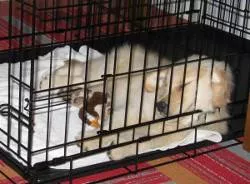
When you are dealing with a brand new puppy or crate training them, it is advisable to put their crate in a bedroom with someone.
Up until this point, new puppies will have slept with their mother and littermates, and sleeping alone can be a big shock for them. Being able to see and hear people during the night will help reduce this trauma, and can help stop them from crying through the night (in which case, no one gets any sleep).
There’s also the question What should I put in my puppy’s crate at night? If your new puppy is really struggling with sleeping alone, then the Calmeroos Puppy mentioned above can help. Remember to adjust your bedtime to match your dog’s because if they sleep early and you show up later turning on lights and tossing things around, you are likely to distract them from sleep and make it hard for them to enjoy the night.
The puppy will only need to stay in the bedroom for a few weeks, after which time their crate can be moved to where they will be sleeping on a permanent basis.
What NOT To Put In A Dog Crate
Food, water, and pee mats aside, there are a few other items you should not put in a dog crate.
First on the list is a collar. In fact, it is best if your dog goes into the crate with nothing on. Let them be in their natural, most comfortable state while inside their crate. Collars, tags, and other related items can also get trapped in the crate bars and end up hurting or even strangling your dog.
Anything connected to a cable, wires, or power cord should also not be anywhere near your pup for this same reason.
The same also goes for battery-powered devices and heating pads. It sounds reasonable to keep your dog warm, but you risk hurting her in the process by using these devices. What if the space becomes too hot and she’s caged? Alternatively, what if she plays around with the items and accidentally fries herself?
What Is Best To Put In A Puppy Crate? (Dog Crate Accessory And Preparation Checklist)
So, to recap what we’ve been over and to summarize the things you should do and buy to make the crate enticing, comfortable, and safe, you should:
- Use Vet Bed as bedding for a puppy until they can be trusted not to chew it.
- Buy a nice, thick, comfortable bed for your dog once you know they will not destroy it.
- Consider a Calmeroos Puppy for a new puppy to comfort them during their first few nights. But once they start chewing with vigor, do not leave any toys in the dog crate at all. These are dangerous if swallowed.
- Always leave two or more durable chew toys in the dog crate to keep your dog’s mind occupied, help them relax, and promote good chewing habits.
- Once you are sure your dog is over their adolescent chewing stage, you can again allow soft toys in the dog crate if you choose.
- Do not leave food or water in the crate unless you are crating your dog for two hours or more or are advised to do so by a vet. However, you can feed them their main meal in the crate, removing the bowl after mealtime.
- Cover your dog’s crate because most dogs prefer it. It helps them relax and provides a more secure feeling. Don’t cover it if they show anxiety or behave as if they truly do not like it.
- Place the crate in the busiest room of your home so your dog is still a part of things and not hidden away.
- Sleep a new puppy in a crate in your bedroom to help them get over the feeling of loneliness, having just left their nest. Move them to their final sleeping place after a few days or two weeks max.
Frequently Asked Questions About What To Put In Puppy Crate
How Big Should A Puppy Crate Be?
Unfortunately, there’s no one-size-fits-all crate for dogs. You just have to take her size into consideration before settling on an option.
Be sure to measure your dog’s length, starting from the nose to the base of her tail, then add an extra 2 to 4 inches. A perfect dog crate size basically allows your pup to stand, lie down, and turn around comfortably. Some suppliers will have charts to guide you. Read more about the process of choosing the right crate size.
Quick tip. The crate should not be too little or have too much extra space. Smaller spaces take away a dog’s comfort and peace of mind, while too much excess space in the crate creates the possibility of accidents.
Should I Feed My Puppy In His Crate?
You can feed your pup in their crate. After all, this is one way to make them believe that great things can happen as she’s caged. But this should be done carefully with a few things in mind.
First of all, don’t place the food in her crate. Occasionally, you can let them out to eat when you are at home, because that’s how they probably love to eat.
Secondly, stick to her feeding schedule, and be careful not to overfeed her, because this will open up the possibility of accidents happening in the crate.
How Can I Make My Dog’s Crate Comfortable?
A comfortable bed and some toys aren’t always enough to guarantee comfort for your dog while she’s inside the crate. First, make sure the crate is of the right size. All the nice accessories will do very little to comfort your dog if the crate is uncomfortable for her.
Comforting scents can also calm your dog while she’s caged, especially if she’s still a puppy. A comforting scent could be from something like a t-shirt or any other item of cloth from you and/or the breeder. The familiarity will go a long way in soothing her.
For dogs that cannot do without water, make sure they have easy access to it. Don’t forget all the safety tips mentioned earlier.
What Should I Put In My Puppy’s Crate? Final Thoughts!
Many people shy away from crate training, as it looks a bit like a doggy prison—and no one likes the idea of punishing their new dog. But crate training is actually one of the fastest and most effective ways to quickly get your dog accustomed to their new home.
The idea of the crate is to give your dog a safe space that belongs to them. They can use it to chill out and relax without fear of other animals or the indelicate hands of young children. They will also learn to “hold it,” as they don’t want to soil their space, making their crate integral to the house training process.
So, how do you make their crate feel like a good place? First, put the crate in the busiest room in your home so your sociable dog can feel like they are part of the action, even when they are curled up inside.
Second, put some creature comforts into the crate. This should include bedding, the familiar smells of the litter for puppies, and toys to keep them mentally stimulated. Just make sure that whatever you put inside won’t be easily destroyed or swallowed, as certain toys can present a serious health hazard.
Do you use a crate with your puppy? What do you include inside their crate? Share your thoughts and ideas in the comments section below or via our social media.

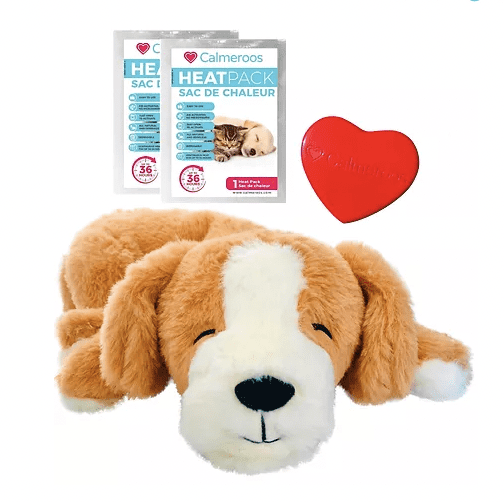
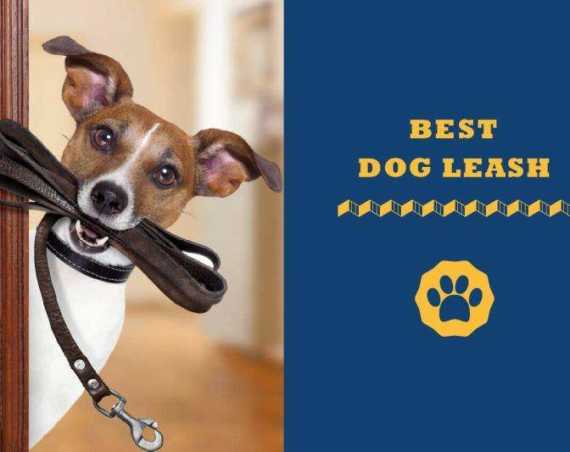

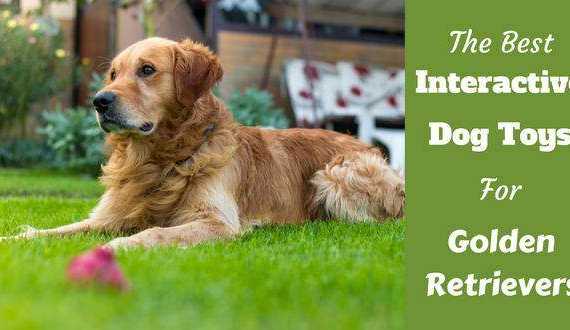
4 Comments
Janet
Hi Wendy-
Our family of 5 ( 2 adults, 3 kids- 12,10, & 6) is about to get a mini Goldendoodle this December. She will be 2 months old at the time of pick up. We have a 2 story house, with all bedrooms upstairs and everything else downstairs. I was planning on keeping the puppy crated in the master bedroom for the first 2 weeks. My question is after the 2 weeks, where should I place the crate? Upstairs in the hallway or downstairs in the family room? We have an open concept kitchen/family/dinning room. Our family spends most of the time downstairs but in the evenings we all go upstairs to finish homework and to get ready for bed.
Any advice would be greatly appreciated. Thank you.- Janet
Wendy
Hi Janet,
Personally I always keep a crate in the busiest area of the house, where the family spend the majority of their time. Dogs spend a lot of time resting, sleeping, in some sort of relaxing state (lucky them!) and when properly crate trained – i.e. they love and see the crate as their own little space – you will find they go to their crate just to chill out and relax of their own accord. You would leave the door open for them, and they can just come and go. This is much better if the crate is in the busiest part of the home, so they can still see and hear everything going on, and feel a part of everything, and for you this sounds like the downstairs family room.
Craig
It’s been about 12 yrs since I create trained a Golden puppy. Being that my wife and I are getting ready to. embrace the joy of a puppy all over agin your insight knowledge and explanations were very helpful
Kari Maddox
It’s been a long time since we’ve had a puppy in a crate, so this information has been so helpful. Thank you!